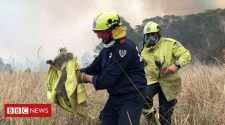Fires burn in the distance after a drone strike by Yemen’s Iran-aligned Houthi group on Saudi company Aramco’s oil processing facilities, in Buqayq, Saudi Arabia September 14, 2019 in this still image taken from a social media video obtained by REUTERS
Saudi Arabia is shutting down half of its oil production after drones attacked the world’s largest oil processing facility in the kingdom, The Wall Street Journal reported.
The closure will impact almost five million barrels of crude production a day, about 5% of the world’s daily oil production, the WSJ reported, citing sources familiar with the matter.
Early Saturday, an oilfield operated by Saudi Aramco, the state-owned oil giant, was attacked by a number of drones, which sparked a huge fire at a processor crucial to global energy supplies.
Yemen’s Houthi rebels have claimed responsibility for the attack, saying it was one of their largest attacks ever inside the kingdom, the WSJ reported.
“We promise the Saudi regime that our future operations will expand and be more painful as long as its aggression and siege continue,” a Houthi spokesman said. The attack involved 10 drones, the Houthis said.
The Saudi interior ministry said the fires were under control.
Saudi officials are considering drawing down their oil stocks to sell to foreign buyers to make sure world oil supplies won’t be disrupted by the attack and shutdown, the WSJ reported.
The Iran-backed Houthis had been behind a series of attacks on Saudi pipelines, tankers and other infrastructure in the past few years as tensions rise among Iran and the U.S. and partners like Saudi Arabia.
The Islamic Republic, a target of U.S. sanctions for decades, has recently attacked oil tankers in the Strait of Hormuz, shot down a U.S. military drone and announced plans to execute 17 suspected U.S. spies.
Saudi Arabia is moving forward to take Saudi Aramco public in a major shakeup of the kingdom’s energy sector.
—Click here to read the original Wall Street Journal story.














